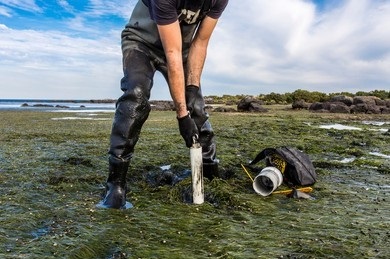
Ocean sediments refer to the bottom sediments formed by various marine sedimentation. Marine sediments are the medium and carrier of the interaction between the atmosphere, hydrosphere, biosphere, and lithosphere, and record the detailed information of the processes of sea-land change and sedimentary environment change. Therefore, Lifeasible has developed a variety of analytical methods to determine the various elements of your interest in marine sediments.
Some of the indicators Lifeasible can measure in marine sediment samples
| Indicators | Methods |
|---|---|
| Determination of total P (phosphorus) | Lifeasible has developed a simple and rapid method for the determination of total phosphorus in marine sediment samples, which has the advantages of simplicity, rapidity, small sample size, and high precision. |
| Determination of Nd (neodymium) isotopes | Lifeasible pre-enriched the samples for Nd and then used MC-ICP-MS (multiple-collector inductively coupled plasma-mass spectrometry) to determine the Nd isotopes with high precision. |
| Determination of δ56Fe, δ66Zn | Lifeasible has developed new chemical pre-treatment methods applicable to the isotopic analysis of Fe and Zn isotopes in marine sediments for subsequent determination using the MC-ICP-MS method. |
| Determination of 90Sr | Lifeasible used the HDEHP extraction technique to determine 90Sr in marine sediments by using the β-counter method for Y determination. |
| Determination of rare earth elements | Lifeasible commonly used methods for chemical analysis of rare earth elements (La, Ce, Pr, Sm, Eu, Gd, Tb, Dy, Ho, Er, Tm, Yb, Lu) in marine sediments are weight method, X-ray diffraction method, ICP-OES (inductively coupled plasma optical emission spectroscopy), ICP-MS (inductively coupled plasma mass spectrometry), etc. ICP-MS has the advantages of high sensitivity, low detection limit, good reproducibility, and the ability to determine multiple elements simultaneously. |
| Determination of OTC (organotin compounds) | Lifeasible has established an HPLC-ICP-MS (high-performance liquid chromatography with inductively coupled plasma mass spectrometry) method for the determination of DBT (dibutyltin), TBT (tributyltin), DPhT (diphenyltin), and TPhT (triphenyltin) in marine sediments. |
| Determination of PBDEs (polybrominated diphenyl ethers) residues | Lifeasible established an analytical method for the determination of more than 30 types of PBDEs residues in marine sediments by ultrasonic extraction with GC-MC (gas chromatography-mass spectrometry). |
| Determination of other elements | Lifeasible processed marine sediment samples by alkali fusion method and used ICP-MS, ICP-OES, and XRF (X-ray fluorescence spectrometer) to simultaneously determine various elements in marine sediments (Cu, Cr, Ni, Tm, Rb, Se, Co, V, Pb, Ta, Ba, Hf, Ga, Cs, Mo, W, Zr, Sb, Nd, Bi, Be, Ho, Yb, Pr and SiO2, Al2O3, Fe2O3, CaO, MgO, K2O, Na2O, MnO, TiO2). |
| Determination of phytosterols | Lifeasible used LC-APPI-MS (liquid chromatography-atmospheric pressure photoionization tandem mass spectrometric) to establish a method for the simultaneous determination of a variety of common phytosterols in marine sediments, with strong resistance to matrix interference, good linearity, recovery, and reproducibility. |
* The test list is still being updated, so please stay tuned.
Lifeasible has extensive experience in the determination of marine sediment samples, and we have established different methods for different indicators to meet the different needs of different customers and to get the best results. This is our specialty and advantage, and you can always contact our staff to determine our service process.